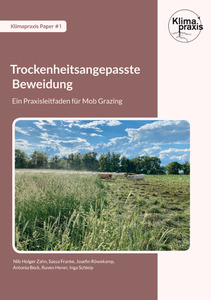{Tool} Drought-adapted grazing: A practical guide to mob grazing. [Trockenheitsangepasste Beweidung: Ein Praxisleitfaden für Mob Grazing.] Creator(s): Zahn, Nils Holger; Röwekamp, Josefin; Franke, Sassa; Beck, Antonia; Hener, Ruven and Schleip, Inga. Issuing Organisation(s): Klimapraxis. (2024)
![[thumbnail of 2025-05-19 13_22_37-Praxisleitfaden Mob Grazing.pdf - Google Drive – Mozilla Firefox.png]](/55660/1.hassmallThumbnailVersion/2025-05-19%2013_22_37-Praxisleitfaden%20Mob%20Grazing.pdf%20-%20Google%20Drive%20%E2%80%93%20Mozilla%20Firefox.png)  Preview |
Image (PNG)
- Cover Image
- German/Deutsch
596kB |
Preview |
PDF
- Published Version
- German/Deutsch
32MB |
Preview |
PDF
- Published Version
- English
20MB |
Document available online at: https://www.mob-grazing.de/praxisleitfaden
Summary
The following chapters are covered in the practical guide:
1) Grazing in Germany: An inventory;
2) Consequences of climate change for agriculture and grazing;
3) What is mob grazing, and when is it useful;
4) Drought-adapted plant populations;
5) Pasture planning;
6) Monitoring plant populations; and
7) Farm structural requirements.
Summary translation
Im Praxisleitfaden werden die folgenden Kapitel behandelt: 1) Weidehaltung in Deutschland: Eine Bestandsaufnahme; 2) Folgen des Klimawandels für Landwirtschaft und Beweidung; 3) Was ist Mob Grazing und wann ist es sinnvoll; 4) Trockenheitsangepasste Pflanzenbestände; 5) Weideplanung; 6) Monitoring der Pflanzenbestände; und 7) Betriebsstrukturelle Voraussetzungen.
| EPrint Type: | Practice tool |
|---|---|
| Teaser: | Stable grassland yields in drought-prone regions and improved soil fertility with Mob Grazing. |
| What problem does the tool address?: | The climate crisis poses major challenges for livestock farmers in drought-prone grassland regions. Many meadows and pastures are no longer producing enough feed due to persistent drought, which results in farms having to remove their animals from the pasture prematurely and buy in feed at high cost. |
| What solution does the tool offer?: | Against this backdrop, a new method is currently attracting the interest of farmers: mob grazing. This grazing strategy originally comes from regions of the world where long dry periods are not uncommon - for example, the prairies of North America or the savannahs of southern Africa. Mob grazing has been used there for decades and provides livestock farmers with stable yields. In Europe, there is still little experience with mob grazing, which is mainly since most grassland regions in this country have not had any rainfall deficits to date. However, this has changed and is making a rethink necessary in many places. Various research projects and practical farms have therefore been studying this method in more detail for several years. The Mob Grazing network has also developed an initiative that aims to promote Mob Grazing as a strategic grazing tool in German-speaking countries. |
| Country: | Germany |
| Type of Practice Tool: | Leaflets & guidelines |
| Keywords: | climate change, climate change adaptaiton, climate-smart agriculture, resilience, water management, grasses, forage, grassland management, grazing lands, cattle, feeds, animal nutriton, agroecology, agroecosystems |
| Agrovoc keywords: | Language Value URI English climate change http://aims.fao.org/aos/agrovoc/c_1666 English climate change adaptation http://aims.fao.org/aos/agrovoc/c_1374567058134 English climate-smart agriculture http://aims.fao.org/aos/agrovoc/c_1361789093890 English resilience http://aims.fao.org/aos/agrovoc/c_1374480530924 English water management http://aims.fao.org/aos/agrovoc/c_8320 English grasses http://aims.fao.org/aos/agrovoc/c_3362 English forage http://aims.fao.org/aos/agrovoc/c_36108 English grassland management http://aims.fao.org/aos/agrovoc/c_3364 English grazing lands http://aims.fao.org/aos/agrovoc/c_3369 English cattle http://aims.fao.org/aos/agrovoc/c_1391 English feeds http://aims.fao.org/aos/agrovoc/c_2843 English animal nutrition http://aims.fao.org/aos/agrovoc/c_27925 English agroecology http://aims.fao.org/aos/agrovoc/c_92381 English agroecosystems http://aims.fao.org/aos/agrovoc/c_36669 English carbon sequestration http://aims.fao.org/aos/agrovoc/c_331583 |
| Subjects: | Animal husbandry > Production systems > Dairy cattle Animal husbandry > Production systems > Beef cattle Animal husbandry > Feeding and growth Environmental aspects > Biodiversity and ecosystem services |
| Research affiliation: | European Union > Horizon Europe > OrganicClimateNET > selected tools European Union > Organic Farm Knowledge |
| Horizon Europe or H2020 Grant Agreement Number: | 101136880 |
| Related Links: | https://organic-farmknowledge.org/tool/55660, https://organicclimatenet.eu/, https://organic-farmknowledge.org/tool/55659, https://organic-farmknowledge.org/tool/55640, https://organic-farmknowledge.org/tool/54300, https://organic-farmknowledge.org/tool/32135, https://organic-farmknowledge.org/tool/54251 |
| Project ID: | OFK |
| Deposited By: | Rüger, Madelaine Lea |
| ID Code: | 55660 |
| Deposited On: | 26 May 2025 09:22 |
| Last Modified: | 26 May 2025 09:22 |
| Document Language: | English, German/Deutsch |
| Status: | Published |
Repository Staff Only: item control page

 Download Statistics
Download Statistics Download Statistics
Download Statistics
